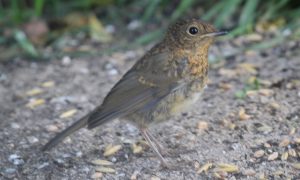 The photograph of a juvenile robin I took in the garden last week gives an idea of how successful some birds were in nesting this year. This robin is from the second brood this summer and it was feeding with a young bird of the first brood that had already moulted and had a red breast. The first nest would have been built in early spring and only the female does the building using leaves, moss and grass. It is an open nest but well hidden in a hollow in a bank, a tree stump or a hole in a wall. They will also nest inside sheds and outhouses if we are obliging enough to leave the door open. They will readily take to what are called open fronted nestboxes where instead of a hole the top half of the front part is open. The 4 or 5 eggs are incubated by the female for about 15 days but the male helps to feed the chicks in the nest and for a short time when they fledge. However, if the female starts a second brood the male will continue feeding the chicks on his own. The young start to be independent after 16-24 days.
The photograph of a juvenile robin I took in the garden last week gives an idea of how successful some birds were in nesting this year. This robin is from the second brood this summer and it was feeding with a young bird of the first brood that had already moulted and had a red breast. The first nest would have been built in early spring and only the female does the building using leaves, moss and grass. It is an open nest but well hidden in a hollow in a bank, a tree stump or a hole in a wall. They will also nest inside sheds and outhouses if we are obliging enough to leave the door open. They will readily take to what are called open fronted nestboxes where instead of a hole the top half of the front part is open. The 4 or 5 eggs are incubated by the female for about 15 days but the male helps to feed the chicks in the nest and for a short time when they fledge. However, if the female starts a second brood the male will continue feeding the chicks on his own. The young start to be independent after 16-24 days.
The juvenile birds soon start to be as friendly to humans as the adults so little wonder that in the national ballot in 2015 to find Britain’s National bird the robin came out on top. This was with a staggering 75,623 votes. It was little wonder that the robin won this competition as for many years people had presumed it was the National bird. However, the final list threw up some surprises and nobody would have guessed that with 26,191 votes the barn owl would come in second. The blackbird was expected to be high on the list as it is another friendly garden bird and it came in third. The wren was next which was no surprise particularly as it is the most numerous and widespread bird in Britain. The blue tit at eight was surprisingly low on the list with only the hen harrier and puffin below. Red kite, kingfisher and mute swan completed the eventual list.
If you think of birds in myths, lore and legend there can be few birds that match the robin. Surprisingly this is not the case in Europe as a whole and this is because there the robin is not the confiding bird it is in Britain. Whilst we may be used to a robin sitting on the garden fence or spade and even waiting for a worm to be thrown to it this is not the case in Europe. There robins will even go around in small groups, unheard of in Britain, and they are much more of a woodland bird. So this is why so much of the myths, lore and legend emanates from Britain. The conspicuous red breast of the robin is a good example of how these myths came about. One is that the robin brought down fire from the heavens for the people to keep warm and was singed in the process. Another is that the robin tried to fan the fire to bring it back to life to keep the baby Jesus warm. In contrast we are not far away from the time of the year when the robin is most popular as it is so commonly used on Christmas cards. Postmen in the 19th century were called “redbreasts “, after their red uniform, and so the robin became commonly used on Christmas cards and this persists to today.
Tags: highland birds
